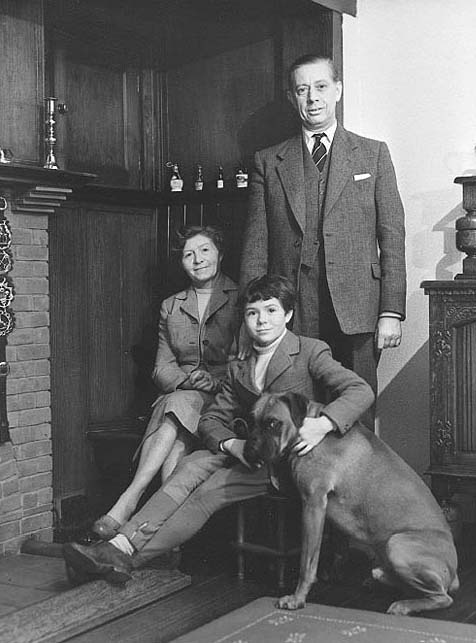Looking at the family: the 1950s
Activity 4
Family photographs may be taken as records, for advertising purposes, or indeed as mementos. Now look at an example drawn from the 1950s (Figure 6). How would you analyse this image? Think about what it tells us of the dimensions of identity, particularly in respect of how such an image might have been used.

Discussion
This is a picture taken in England around 1955–56 by a professional photographer but for the private use of the people depicted. It shows a family: a woman, a man, and their child, and the family dog, at home. Let us think about the uses to which such an image might have been put. The context of use is important, for it tells us about the social functions such an image performs (Hirsch, 1981).
In this case, the photograph was framed and placed on a sideboard. This tells us two things: first, that it was considered a pleasing likeness of the people depicted: second, that the picture was also an effective depiction of the social group that they constituted: a nuclear family. Notice that the picture was made in the hearth of the room (the ‘centre’ of the house, of the domestic sphere). See that the father is standing over the mother, the child and the dog, and the picture has been made from a level on a par with the child and woman, but lower than the eye-level of the man. We look up at him, a composition often used to emphasise the heroic or powerful nature of a person. Also notice how the woman and child are closer to the hearth, and that the man is positioned less closely to them. A degree of separation, in status, in gendered identity, could be inferred from this, as well as the separation between the domestic and private sphere inhabited by the woman and child (and dog), and the external sphere which is the man's domain. Notice also the dress of the people depicted and the furnishings on display. These are indicators of class and status, as well as of ethnicity and, by implication, national identity.
We can be fairly sure that, whatever else it is as a picture, this photograph could also be said to be a reaffirmation of the social group that the family represents. Family photography, as one sociologist has pointed out, is an index of social integration (Bourdieu, 1990). However, as we remarked earlier, the act of photography also confers historical importance on the event depicted, more particularly where this has occurred in a formal context such as here, where a professional photographer has been called in to make the group portrait. Thus the picture fixes identity in a socially important manner.
3.2.1 Summary
-
A content analysis looks at what is shown in the picture itself.
-
A context analysis focuses on the processes involved in the creation of the picture.
-
Social scientists need to employ both approaches.
